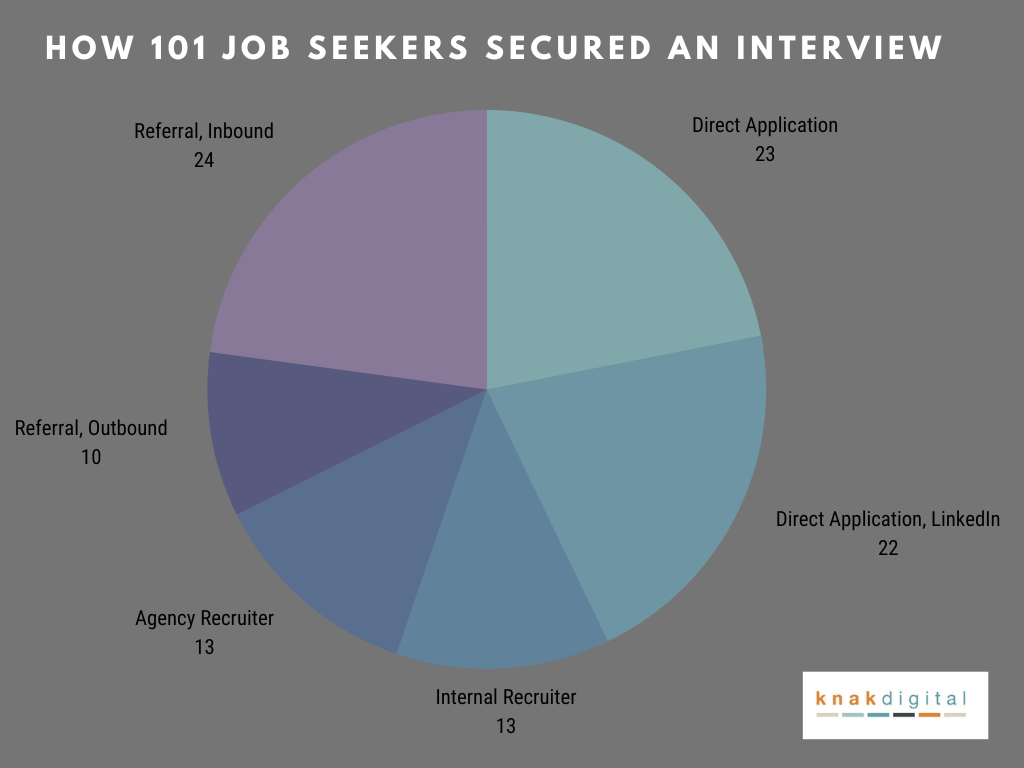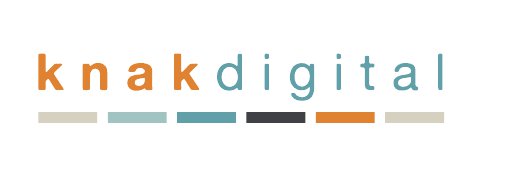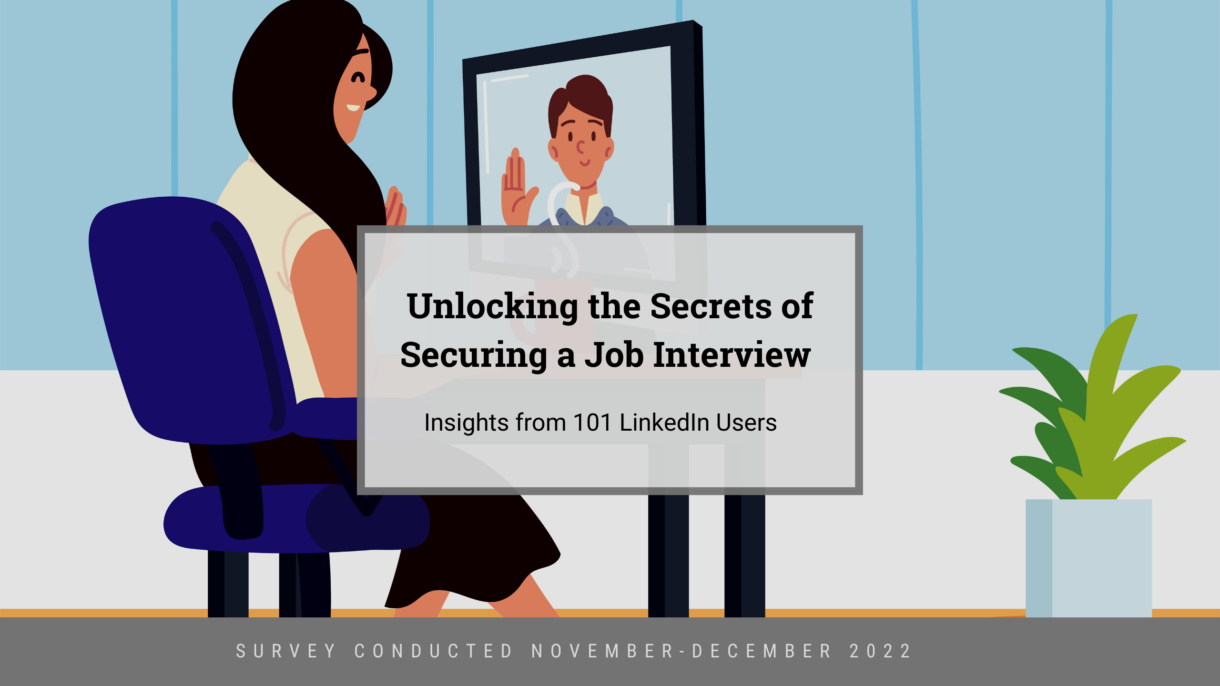If you’re job searching, you may be wondering what the best way is to secure an interview and ultimately, an offer.
“Networking is the best way to find a job.”
Says everyone
I’m not downplaying the importance of networking, but let’s not neglect the other channels that job seekers can use to capture the attention of a recruiter or hiring manager.
To get some insights, I surveyed a group of 101 LinkedIn users who work at companies ranging from Fortune 100’s (such as JP Morgan, Deloitte, EY, and GM) to tech companies (like TikTok and Zillow) to SMB’s (boutique agencies and startups).
The final tally of how my network secured their interviews and offers was as follows:
- Direct application: 19
- Direct application on LinkedIn: 22
- Internal recruiter: 13
- Agency recruiter: 13
- Referral inbound: 10
- Referral outbound: 24

Let me clarify how I categorized the responses:
- Referral, Outbound means that the person initiated outreach to a recruiter, employee, or hiring manager.
- Referral, Inbound means the person received outreach from an employee, friend, former coworker, or hiring manager.
- Direct Application refers to the applicant using online systems (ATS, job boards, corporate websites, LinkedIn as noted) to initiate interest for a phone/in-person interview.
- Recruiter tallies were all inbound messaging, meaning that a recruiter reached out to the candidate. Any situation where a person reached out to a recruiter would have been “referral, outbound.”
- Recruiter, Agency refers to an external, 3rd party agency or consulting firm
- Recruiter, Internal refers to an internal employee of the company
It’s worth noting that this sample is only from LinkedIn users, and my network demographic is primarily in tech and marketing, so there may be some selection bias. However, these results can still give you an idea of what methods are commonly used by job seekers in these industries.
But wait, before you start applying to every job posting in sight, here are some fun facts from each category:
✔ Direct Application:
- 3 of them used the “Easy Apply” function on LinkedIn, because who doesn’t love easy?
- They also applied through channels such as the company website, Indeed, and Hired. So, diversity is the key!
✔ Recruiters:
- It’s a tie! Both agency and internal recruiters reached out to candidates.
- None of the candidates reached out to recruiters themselves. So, it’s not always about who you know, but who knows you!
✔ Referral Inbound:
- 3 of them made public “Open to Work” posts about their job search on LinkedIn, and it paid off!
- It’s all about being open to opportunities and networking.
✔ Referral Outbound:
- 2 Jobseekers reached out to hiring managers who posted the job on LinkedIn.
- Sometimes, the best way to get a job is to go straight to the source.
So, there you have it, folks! A variety of methods can secure you an interview and an offer, from applying directly to reaching out to recruiters or leveraging your network. Remember, it’s all about being open to opportunities and using a combination of methods to increase your chances. Happy job hunting!
Drilling down on Senior Level Hires:
After posting my initial findings, I had several inquiries from my network questioning if different channels and methods that job seekers at senior or leadership levels have used to find their current positions followed a similar pattern.
I revisited the results and here’s an overview:
- Direct application: 3
- Recruiter: 3
- Referral Inbound: 5
- Referral Outbound: 4
The job titles included a CMO, CTO, 5 VP of Marketing, 2 VP Product, VP Digital, VP Hospitality, Employer Brand Lead, Sr. Management Consultant, Director Digital, Associate Director.
Let’s pull back the layers
While the sample size was small, I had the advantage of interacting with each one to gain more insights beyond the strategy.
I found a few patterns and categorized the multiple tactics used by those I polled:
Response from an Open-to-Work Posting on LinkedIn:
- VP Product: A hiring manager reached out when they say his layoff LinkedIn post
- Engineer: Ex-colleague saw his LinkedIn post
Referral from a Former colleague:
- Manager: A former EVP reached out to me
- Director of Product: A prior boss became the CPO of company she with now. SHe had kept in contact with her about opportunities.
- Digital Lead: Recruited by a former supervisor I had kept in touch with throughout the years (and respected her management style).
- Product Marketing: Recommended for the role from a prior CMO
Twofer:
- Art Director: Applied through LinkedIn, but was working with an external recruiter she knew as well. Both reached out simultaneously, and she worked through the recruiter.
Leveraging Communities:
- Head of Marketing: Posted in a b2b Marketing community. Within 24 hours, she had interviews linedup.
- CMO: Noticed the posted in a Marketing Community.
- Design Lead: Saw the posting in a Google Group. Applied through the company website.
Not then, but now:
- VP Digital: The timing was off a year ago to move into a full time role, but a new position opened up and the timing was right.
- Analytic Director: Two years ago, the position wasn’t the right fit. She saw they were hiring again and this time, right time and fit.
- Designer: Interviewed in 2019 and didn’t get the job due to internal issues. A position opened up (saw on LinkedIn) and she messaged the hiring manager.
- Marketing Ops: Interviewed and was in negotiation stage, but the pandemic hit and hiring froze. She received a callback 2+ years later.
Target Company:
- UI Designer: She joined the company email list for job alerts. Job alert! Submittal.
- Engineer: Learned about the company through his network. He frequently checked the jobs and jumped on one when it opened.
Networking Event:
- Social Media: Met an employee at a networking event and they connected them to the job.
- Head of Product: Met the contact at a conference in several years ago. This contact reached out to her for the position.
Keyword optimized:
- Design Engineer: My manager has searched “data experience designer” (her title from a prior job) and her name popped up. The manager reached out about the job.
Clients:
- Marketing Director: Company was a prior client 10 years ago and they reached out to him.
- Product Design Manager: Was a subcontractor for the organization through the parent company and was hired on FT.
But what’s the Employer’s version?
There’s no twist to these stories–they all ended in an accepted offer.
But as a recruiter, I know there are other factors that could have boosted these job-seekers’ odds.
Online Presence
How many recruiters were cross-referencing LinkedIn or online portfolios to research applicants who applied directly? Especially pertaining to the Easy Apply votes, where your LinkedIn profile IS your resume.
Quality of Resume
Wouldn’t it be interesting to have reviewed the resumes that were converted to interviews through a direct app?
(I”ll take a wild guess, but there’s no secret sauce. No special formatting. The content of the resume articulated how their skills, abilities, and achievements would help solve the business’s objectives.)
How did the Recruiter find you?
As I had defined above, I accounted for all recruiter votes to be inbound. However, I wasn’t able to talk to the recruiters about how they had sourced the job seeker.
A few possibilities could have included:
- Online presence, from social media platforms, Boolean search strings, coding repositories, or personal portfolio URLS. This includes optimization of using relevant keywords
- Found their information in their ATS system from a dated job listing or talent community
- Referral or tip from network
- Activity (like content creation) to promote their online presence.
Brand Recognition
Working for a well-known brand or competitor will increase the chances of a recruiter or hiring manager reaching out to you. (Not a guarantee).
Networking
Networking is a VERY broad term. Referrals? 100% a result of building relationships with people who can help support or advance your career.
Several of the respondents had leaned into their communities and even in-person networking events to generate or seek out opportunities. #Networking
LinkedIn is an online social network, but it doubles as means of communication–some of which are completely cold messages. If we’ve never exchanged communication, I’m not designating that as networking.
There’s no blueprint for success
You can’t compare your job search to someone else’s, because your experience, tools, and execution is not going to be parallel to theirs.
What weighs into the outcome?
- Timing
- Messaging
- Supply & Demand of Skill set
- Aptitude of skill and experience
- Ease to be Found (Optimized)
- Networking bandwidth and activity
- Time allocated into job search
- Diversifying channels
- Clarity and translating that into your tools
My personal take is that a combination of these principles can increase your chances of nailing an interview. If you aren’t making traction, experiment and change it up.
- Seek out new ways to network (communities appeared to be a valuable resource for a few in this poll).
- Test new keywords (but make sure you can back them up with proof of experience).
- Tailor your resume. Ask a trusted colleague or mentor to review.
- Find recruiters in your industry who can help
- Go back to square one–are you clear about your objectives, strengths, and abilities? If you can’t communicate your qualifications and targets, an employer is going to be confused and underwhelmed.
Diversify your job search strategy, be flexible, and be kind to yourself. A positive mindset will be noticed and be the fuel that drives your motivation in the process.



